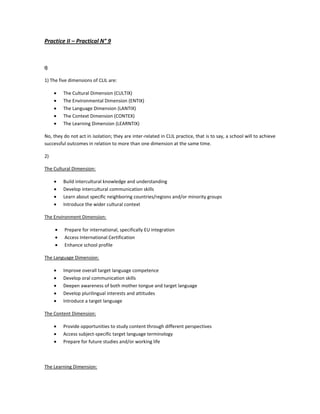
Practical 9 ximena beiras, gisela nacini
- 1. Practice II – Practical N° 9 I) 1) The five dimensions of CLIL are: The Cultural Dimension (CULTIX) The Environmental Dimension (ENTIX) The Language Dimension (LANTIX) The Context Dimension (CONTEX) The Learning Dimension (LEARNTIX) No, they do not act in isolation; they are inter-related in CLIL practice, that is to say, a school will to achieve successful outcomes in relation to more than one dimension at the same time. 2) The Cultural Dimension: Build intercultural knowledge and understanding Develop intercultural communication skills Learn about specific neighboring countries/regions and/or minority groups Introduce the wider cultural context The Environment Dimension: Prepare for international, specifically EU integration Access International Certification Enhance school profile The Language Dimension: Improve overall target language competence Develop oral communication skills Deepen awareness of both mother tongue and target language Develop plurilingual interests and attitudes Introduce a target language The Content Dimension: Provide opportunities to study content through different perspectives Access subject-specific target language terminology Prepare for future studies and/or working life The Learning Dimension:
- 2. Complement individual learning strategies Diversity methods of classroom practice Increase learner motivation 3) CLIL can offer a natural situation for language development which builds on other forms of learning. This means that CLIL creates real-life situations in which young children can acquire the language. It is proved that these opportunities are more fruitful than the artificial classes at weare used to. 4)Children are exposed to the target language in a meaningful way; they learn it in real-life contexts. First, they learn the subject in their L1 and then they study it in a foreign language, in this case, English. This can be considered a learning strategy that helps children process the input in order to prepare them to develop higher-level thinking skills in the subject. Children possess language awareness, and because of that, they can understand that there are differences and similarities between their L1 and L2.Besides, that language awareness helps children to develop the intercultural knowledge and understanding; that is to say, children realize that there are culture differences. ICT can be a learning strategy and can also allow children to interact and communicate with children of other cultures. III)CLIL class for Primary School level. Aims: To study the environment and human actions that affect the former. To name the consequences of these human actions. To review vocabulary related to the environment and pollution. To use the modal SHOULD/SHOULDN´T to give advice. To design posters in order to inform the whole school about the human actions that affect the environment. To design posters giving advices about what people should and shouldn´t do to help the environment. Content: The environment. What people should or shouldn´t do in order to help the environment and reduce pollution. Language: Lexis related to the environment. Modal SHOULD/SHOULDN´T. Skills: speaking and writing. Procedure: Ask pupils what they know about the environment and the factors that affect it. Analyze pictures about different situations caused by the pollution of the environment.
- 3. Ask children if they do something to reduce pollution. Collect ideas on the board to make sure that all children have a complete list of human actions that affect the environment and what people should and shouldn´t do in order to reduce pollution. In groups of 4/5 students each, design two different kind of posters according to the ideas mentioned before. They can work with the help of …………… teacher. Extension: Students produce a Power point presentation applying all they have learnt. Upload the Ppt to the blog that they have already created to share it with students from other parts of the world.